Food & Drink
Baltimore Pastry Chefs are a Rare But Important Part of Restaurant Teams
Exploring why, these days, pastry chefs are often as much of a luxury as the desserts themselves.
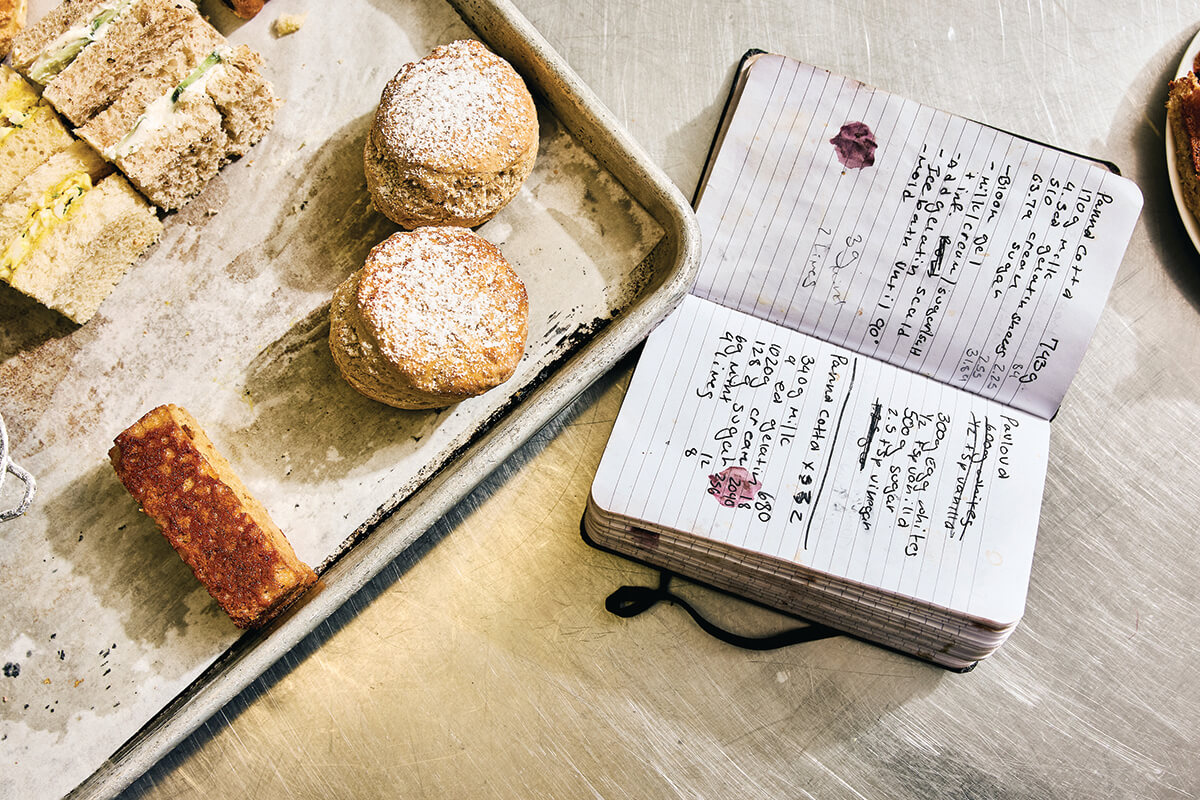
Deep inside the recesses of Magdalena, pastry chef Emily Heleba stands at the restaurant’s kitchen counter pouring chocolate glaze over disks of frozen chocolate mousse. Once enrobed, the desserts, which sit atop layers of crispy cocoa dacquoise, will be decorated with filaments of gold leaf before they’re served to diners at the fine-dining restaurant at the heart of The Ivy Hotel, a circa-1890s Mt. Vernon mansion.
A Molteni stove—a black-enameled, brass-fitted behemoth made in France to Magdalena’s specifications—fills the center of the kitchen, a vat of stock bubbling away on a corner burner. Across from that stove, Heleba has an entire station at her disposal, as well as a designated refrigerator. That set-up is unusual in today’s restaurant kitchens, many of which don’t have a pastry chef, much less a dedicated pastry station.
A pastry chef, or pâtissier, is an integral part of a classic French kitchen brigade, responsible for all desserts as well as breads and baked goods, plus many batters, fillings, and doughs. But increasingly, due to financial constraints, restaurants have done away with many traditional kitchen positions, consolidating them or outsourcing the work.
When money is tight, the pastry chef is often the first to go, as it is a labor-intensive position that doesn’t bring in a lot of money (people often skip desserts). And high-quality desserts can be purchased from bakeries or private kitchens, as can breads and sweets. These days, pastry chefs are often as much of a luxury as the desserts themselves.
THESE DAYS, PASTRY CHEFS ARE OFTEN AS MUCH OF A LUXURY AS THE DESSERTS THEMSELVES.
The restaurants that can afford pastry chefs tend to be those that use them for more than just the desserts of one kitchen. That includes corporate restaurants that have one pastry chef who bakes desserts for a few restaurants out of one central kitchen or larger restaurants that have private dining rooms for events, such as weddings, birthday parties, and business meetings.
And then there are hotel restaurants like Magdalena, where the pastry chef is also responsible for events such as tea service and hotel breakfasts and gatherings.
“I feel very lucky to have found a place that wants a pastry chef,” says Heleba as she slices strawberries and adds them to profiteroles filled with diplomat cream (a mixture of pastry cream and whipped cream), which will join bite-size scones and tiny tea sandwiches presented on a two-tiered tea tray.
“When I was doing my job search out of school, pretty much every job listing was line cook, line cook,” she says. A graduate of Johnson & Wales, a preeminent culinary school in Rhode Island, she grew up in Ellicott City. “A lot of my chefs at school were very clear that it was going to be a struggle for us to find places where we’re needed and that we would most likely have to pick up savory skills as well along the way.”
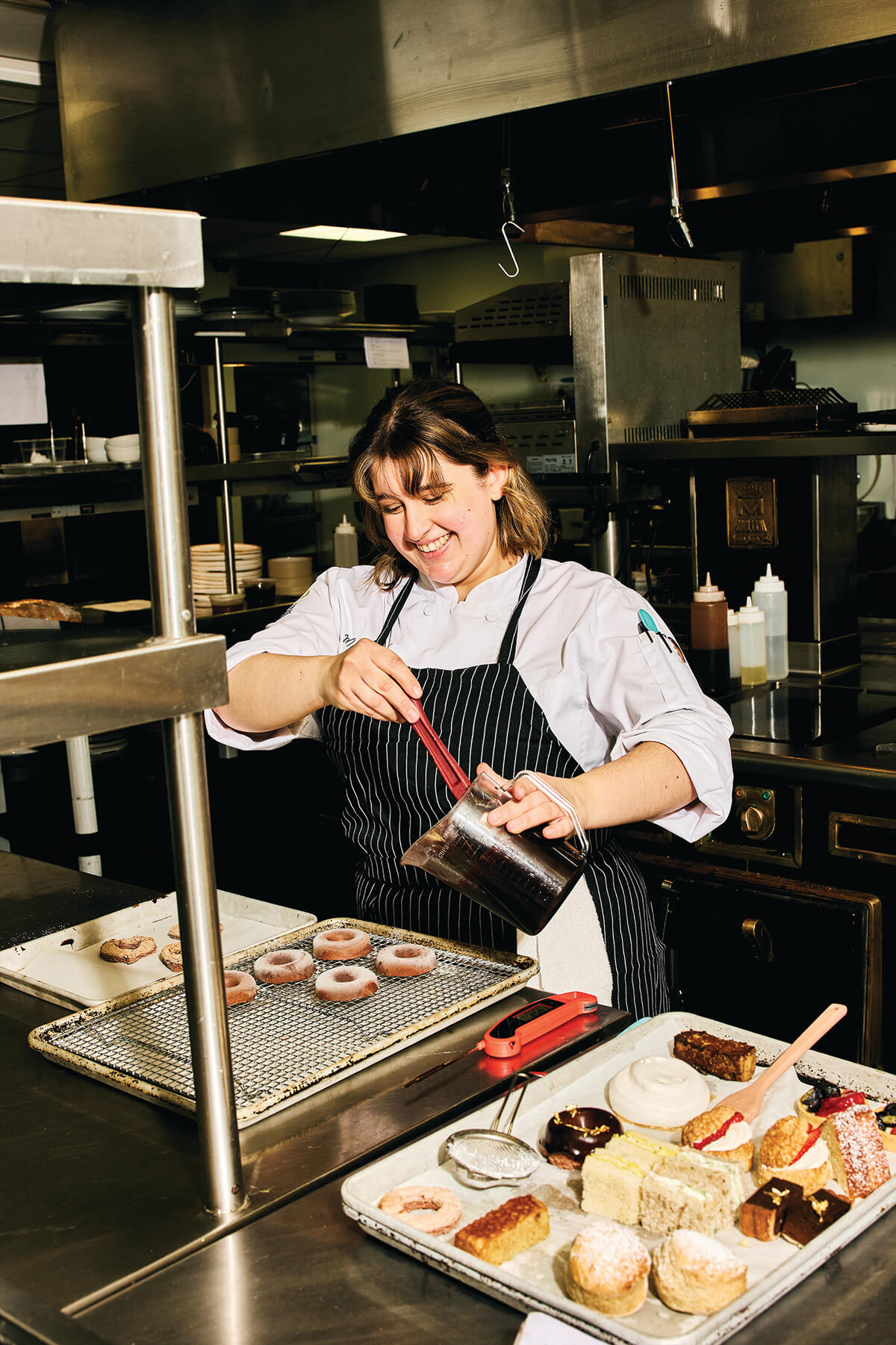

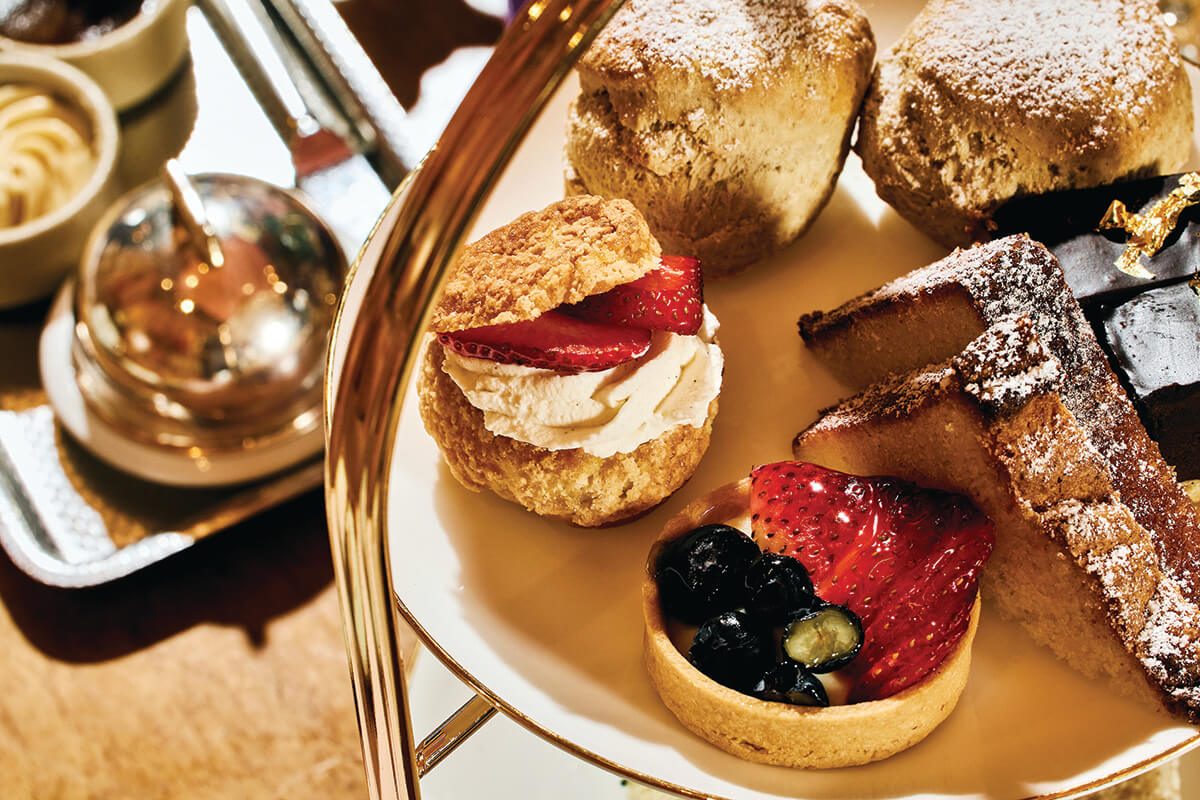
At Magdalena, she’s part of an eight-member kitchen staff who serve the 65-seat restaurant, as well as doing events, serving high tea to hotel guests in the well-appointed (hand-painted walls, stained glass windows) lounge on the hotel’s second floor, and, as of this spring, outside diners as well.
Many of the teachers at Johnson & Wales, Heleba says, advised looking at hotels for work. “You’re doing bread, you’re doing desserts, you’re doing breakfast in some cases. There’s a need.”
But that advice applied mainly to big chain hotels like the Four Seasons, so she’s especially grateful to have found a position at a boutique hotel, where she can be part of a small kitchen and do more personalized work. “I feel like it’s so much more meaningful,” says Heleba.
Gunther & Co. in Brewers Hill doesn’t have a hotel to help finance the restaurant’s pastry program, but it does have private dining rooms as well as a huge main dining room in the space, the century-old boiler room of the Gunther Brewing Company.
Longtime pastry chef Jessica Banner has been at Gunther for seven and a half of the nine years it’s been operating, and her pastry program encompasses not only desserts, but breads—including the popular Parker House rolls—and hamburger buns, as well as much of the weekend brunch menu and integral parts of the event menus that fuel Gunther’s engines.
“I like the combination of science and comfort,” says Banner, who credits her grandmother, who worked as a dairy farmer in England, as part of the reason she felt drawn to pastry. A musical theater major in college, she went to the French Culinary Institute and trained in restaurants, including Wylie Dufresne’s legendary wd-50 in New York City.
Like Heleba, Banner feels lucky to have found her current position. When her last job ended after the restaurant closed, “I was like, ‘Oh gosh, what’s next?’” she says. “Because there are so few places that employ just a pastry chef.”
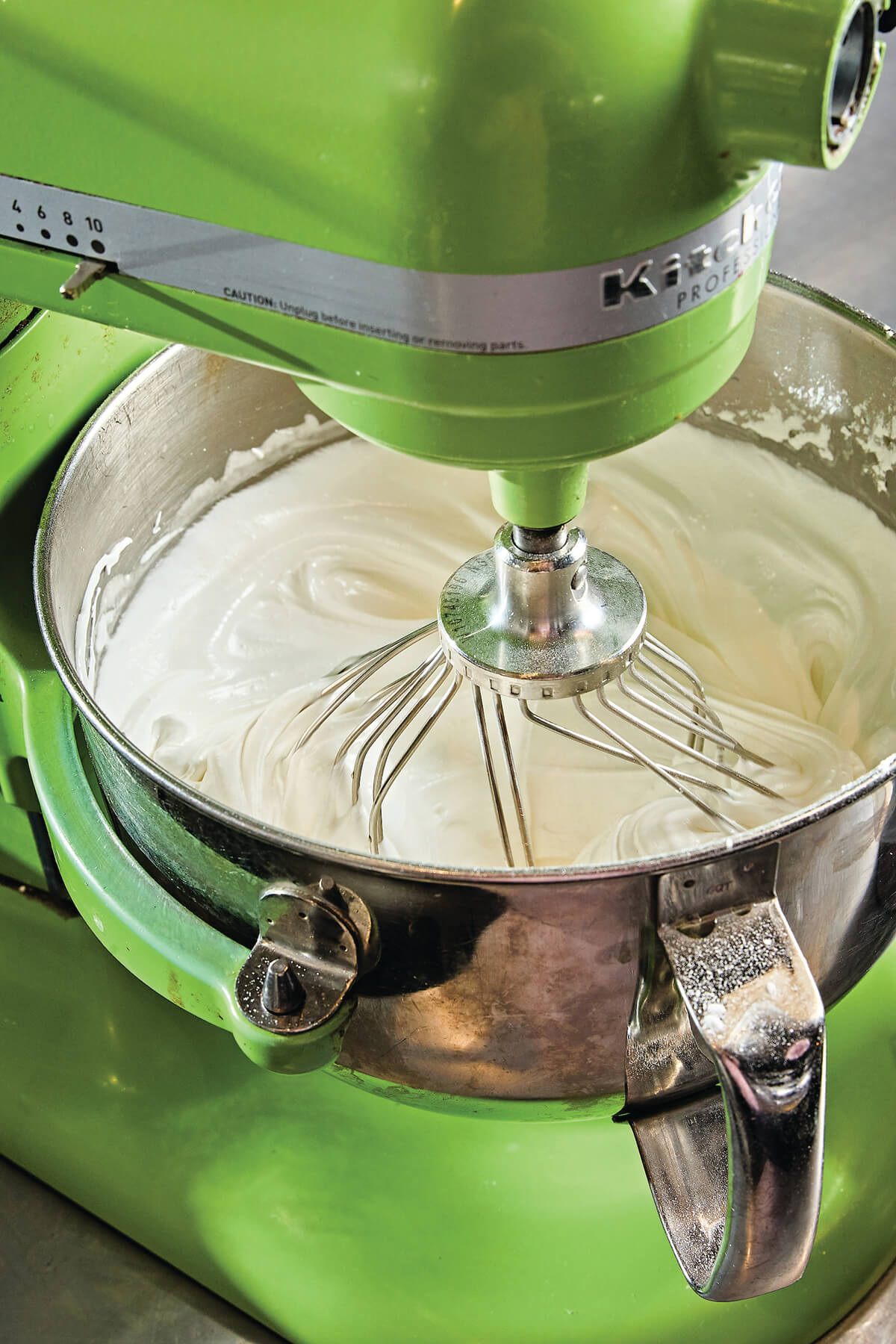
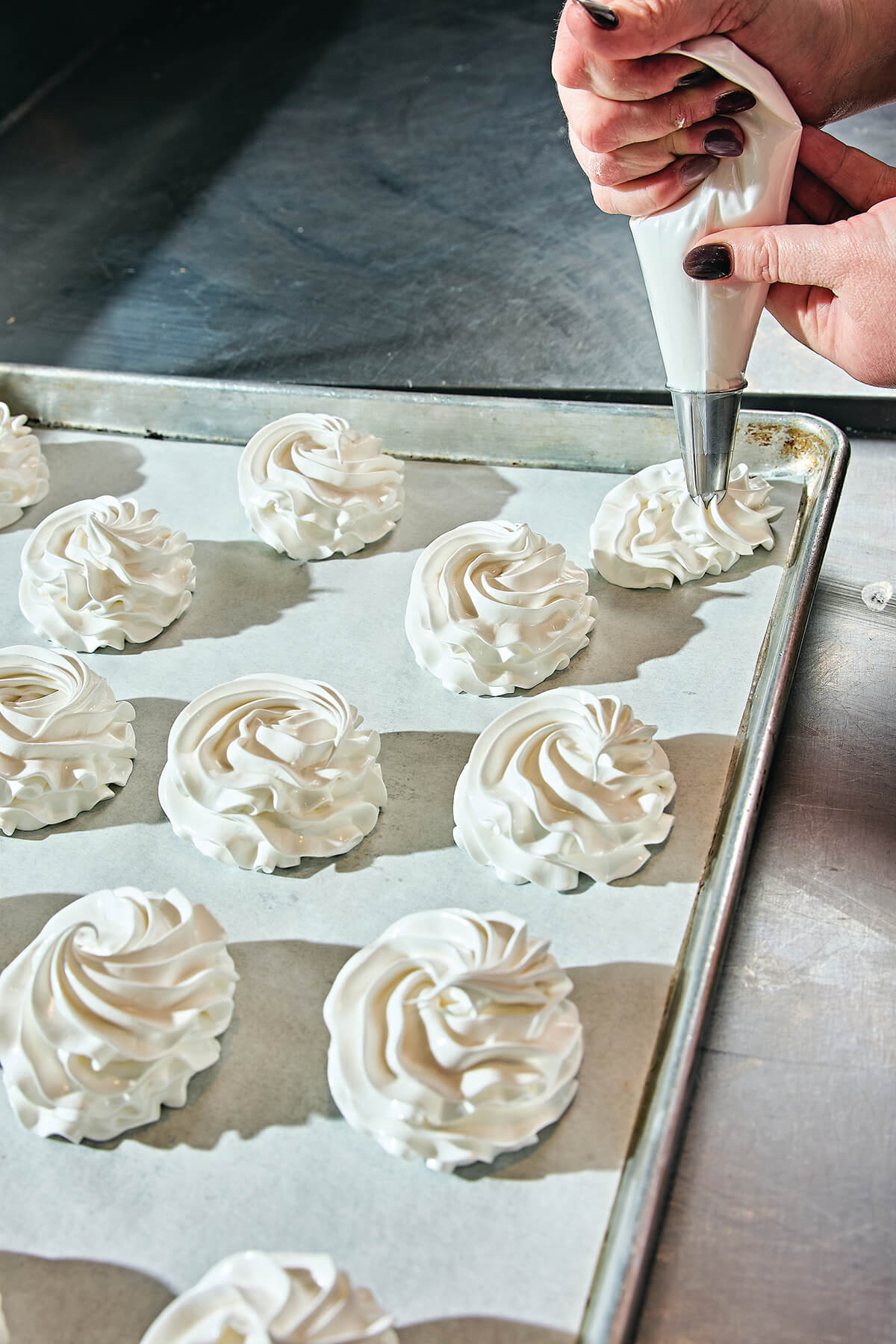
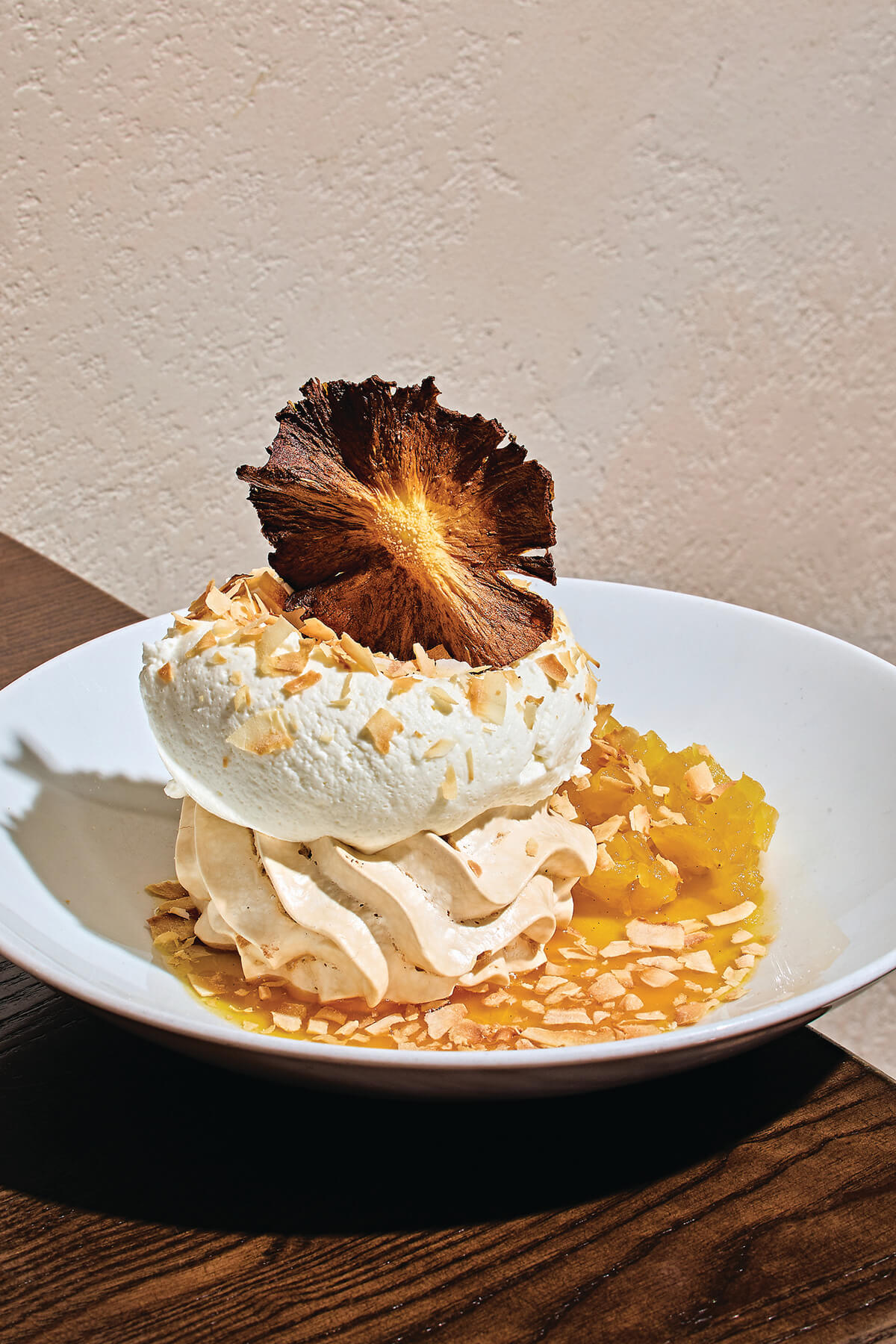
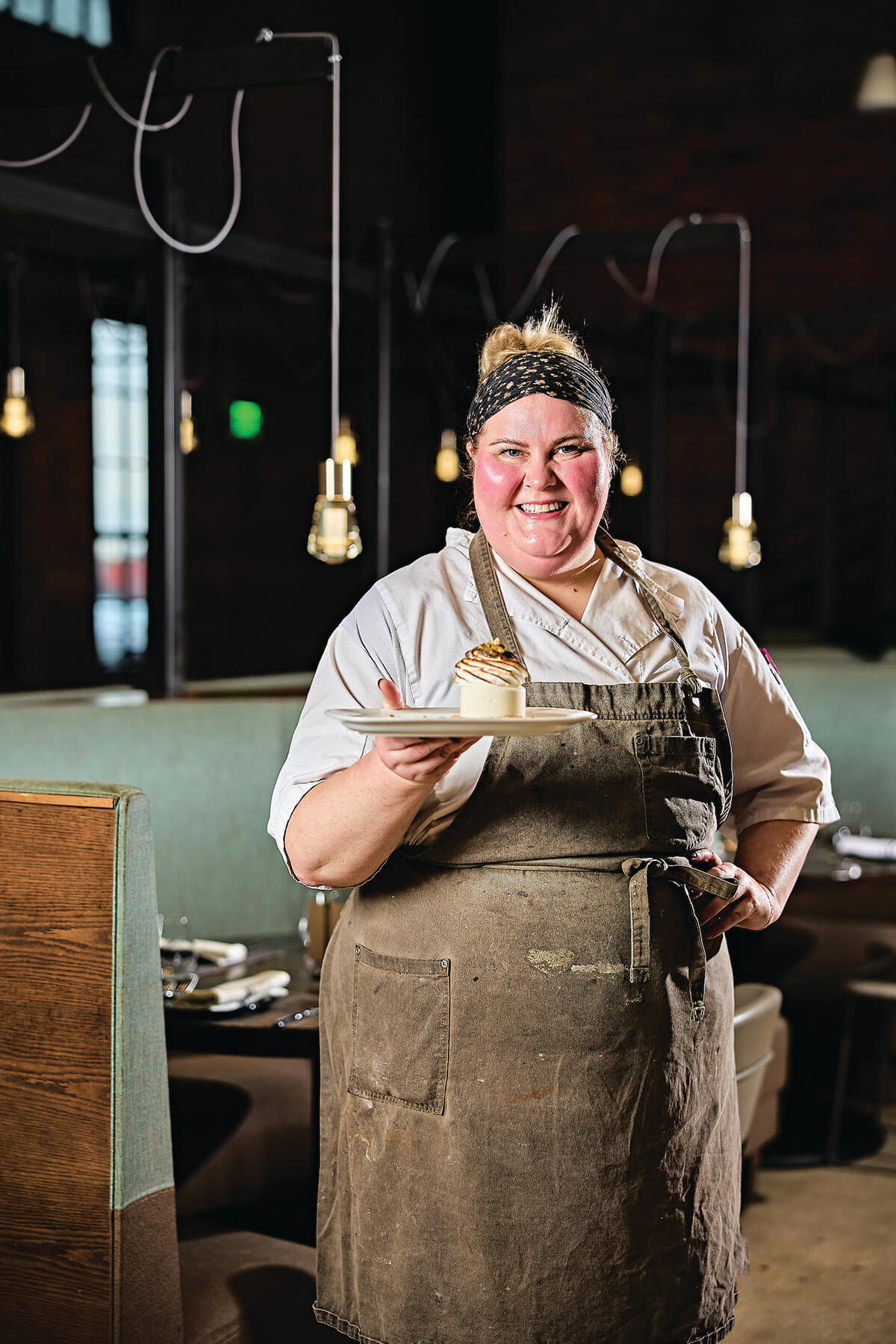
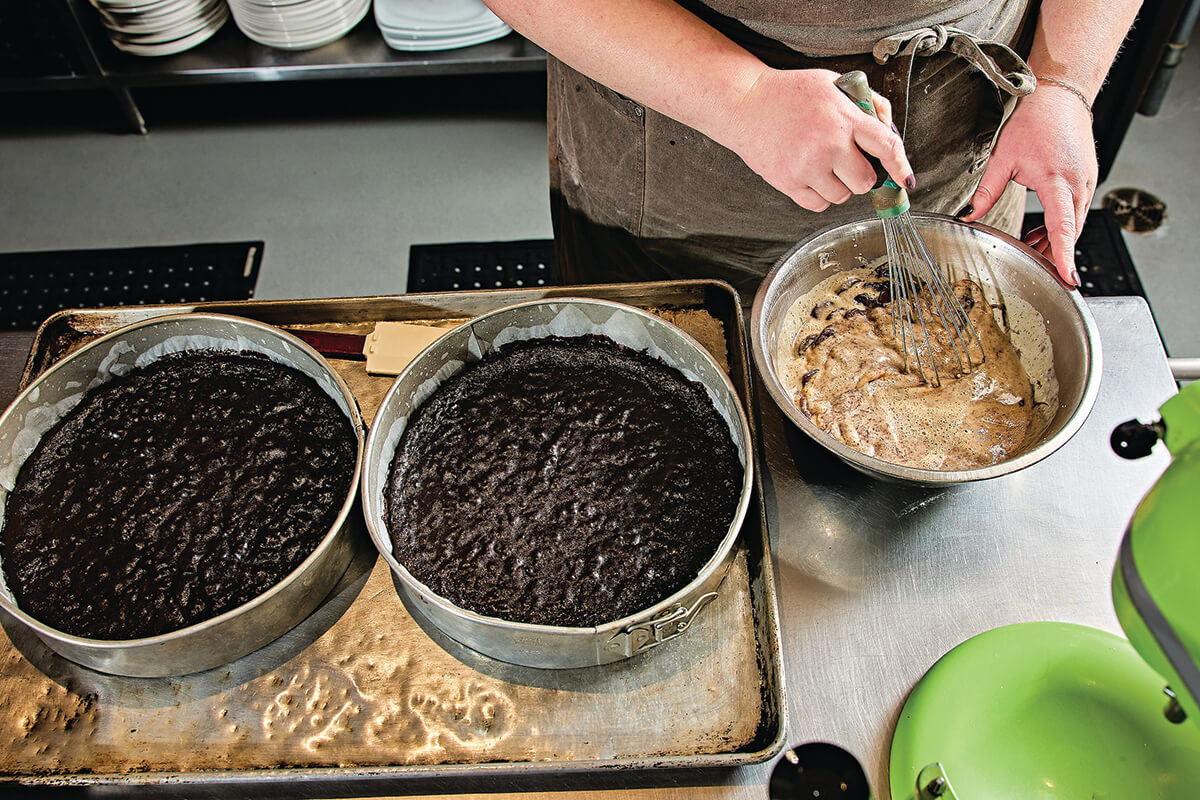
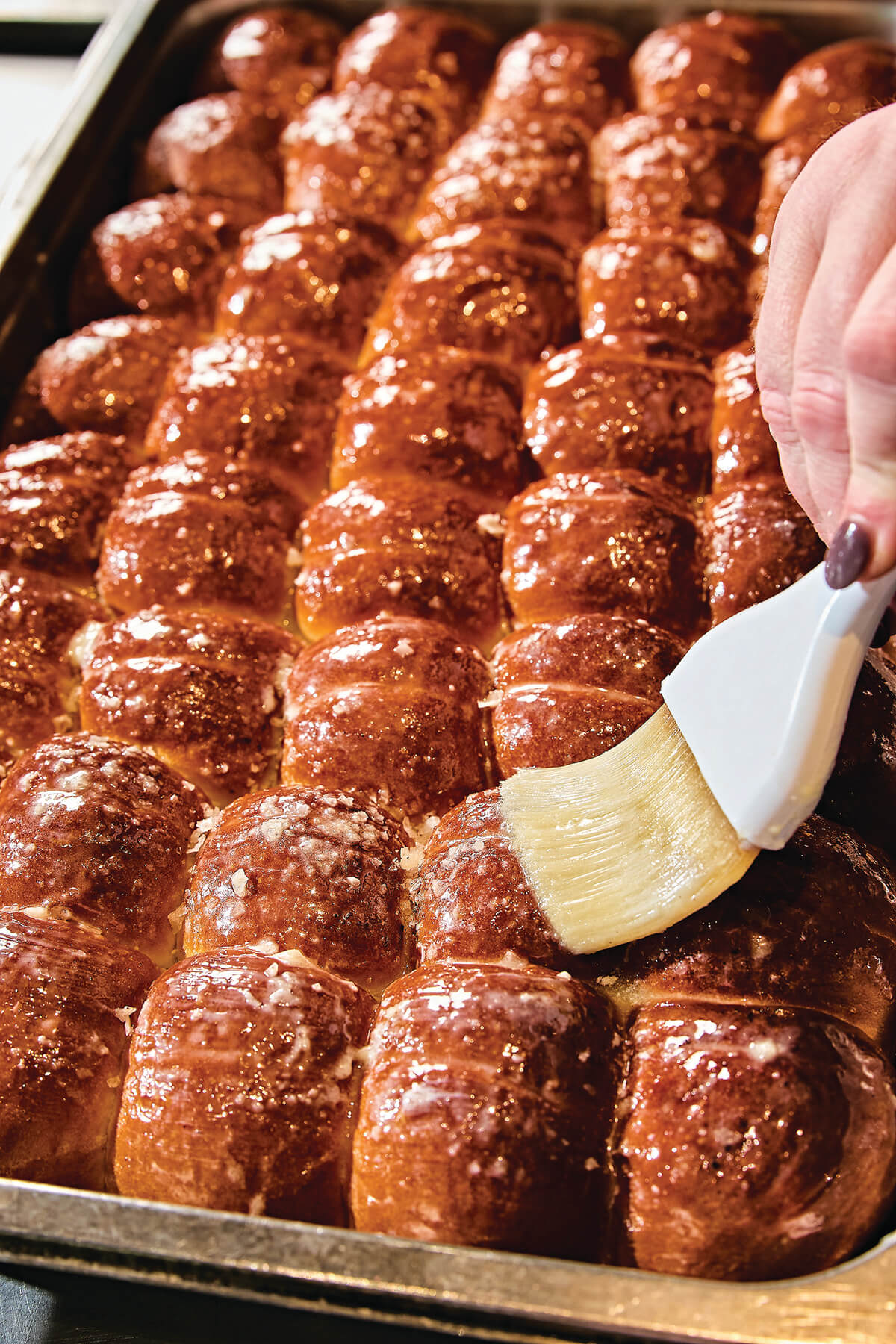
In Gunther’s large open kitchen, Banner whips meringue in a lime-green KitchenAid, then pipes it onto a sheet pan lined with parchment paper for the Pavlovas she’ll serve that evening—gorgeous architectural desserts built of meringue, passion fruit coulis, coconut-milk cream, and roasted pineapple compote, crowned with golden disks of dehydrated pineapple.
“You’ll have small restaurants that don’t want to employ pastry chefs,” she continues. “They put some cook on the team in charge of, like crème brûlée or a chocolate thing and call it a day. Sure, you can make that work. But [dessert] is so important, it’s what you remember; you can really round out people’s experiences.”
Banner’s point underscores the difficulty of consolidating desserts and baking into the job of a restaurant staff without a pastry chef.
“They’re really two different animals, right? To be a chef and to be a pastry chef,” she says. “I don’t pretend for a minute that I can hop behind that line and break out the things that those people do. It’s really a science. You need the space and you need the hours.”
Pastry programs not only require specifically trained pastry cooks, but they also require, as Banner points out, space and time. Pastry chefs need prep time and oven space for baked goods, which is often at odds with what happens in the rest of the kitchen. Working with chocolate and other dessert ingredients can require cooler temperatures—the reason why bakeries often have specific colder rooms and marble countertops—while ovens need higher heat or convection settings for breads and pastries. Flour can migrate, which can be a concern for gluten-free guests.
And then there is the cost—not only of the pastry chef’s salary, but of ingredients like chocolate, butter, and eggs, not to mention gold leaf and high-quality fruit.
“IF YOU WANT TO BE A TOP RESTAURANT, YOU NEED HOMEMADE DESSERTS, YOU NEED A PASTRY CHEF.”
“The art of pastry is dying,” says Gunther co-owner Nancy Hart Trice, a former chef herself. She says when she moved back to Baltimore 20 years ago, many restaurants weren’t able to afford to keep pastry chefs. This has only gotten worse with the pandemic and inflation. “It was very important to Jerry [Trice, her husband and co-owner] and me that we figure out how to make it work, like making the bread and ice cream. We wanted everything to be from scratch, like having a brunch program that has homemade doughnuts. I think people can taste that,” Trice continues. “If you want to be a top restaurant, you need homemade desserts, you need a pastry chef.”
Spike Gjerde, the only Baltimore chef to have won the James Beard Foundation’s award for Best Chef Mid-Atlantic, has always had a designated pastry chef at Woodberry Tavern, where he’s both chef and owner. Gjerde, in fact, started his career as a pastry chef; his first job was at Baltimore’s Pâtisserie Poupon.
“Pastry was always part of our mix,” says Gjerde. “For me, it wasn’t a question of whether we should have a pastry chef. Where it really makes sense for me, is if you have baking kind of baked into the kitchen approach.”
For Gjerde’s pastry chefs, this is feasible because they also bake for Artifact, the coffee shop down the road from Woodberry, which has a stellar menu that includes English muffins and biscuits as well as an elaborate breakfast and lunch menu. The pastry team contributes to Woodberry’s events, and is an integral part of the restaurant’s menu, not only for the desserts, like a spectacular baked Alaska (ginger cake, apricot ice cream, flamed at table), and a popular brunch, but elements of the savory side like the smoked oyster pie.
“I think that has a lot to do with me coming up in the pastry kitchen,” says Gjerde. “It’s definitely the scale that helps. If it was just one [restaurant], it would be a real stretch to have a pastry chef. What it comes down to with pastry is that it’s skilled labor that’s costly, as it should be, and so it’s hard to make it work.”
Getting creative is part of the program. At Foraged in Station North, that creativity is on display with pastry chef Josi Stewart’s desserts, but also with her hours: To go full-time, she also works the front of the house. Stewart, who is self-taught, bakes the bread as well as making desserts to pair with chef Chris Amendola’s seasonal menu, but she knew from the start that the restaurant wasn’t big enough to justify a full time pastry chef. She’d worked front-of-house before, though, and enjoys that aspect of the job, which allows her to speak with guests—some- times even about her desserts.
“Getting that one-on-one contact with the guests when they’re actually having the [dessert] is huge. A lot of people want to talk about it.”
Foraged makes its own ice creams and also has a prix-fixe menu that always includes a dessert, as well as a cocktail menu that can include small dessert items, like pairing prosecco with sorbet.
“Because of how seasonal things are and how often the menu changes, there would be no other way to do it,” Stewart says about having an in-house pastry chef, noting Amendola’s emphasis on hyper-seasonal and foraged ingredients.
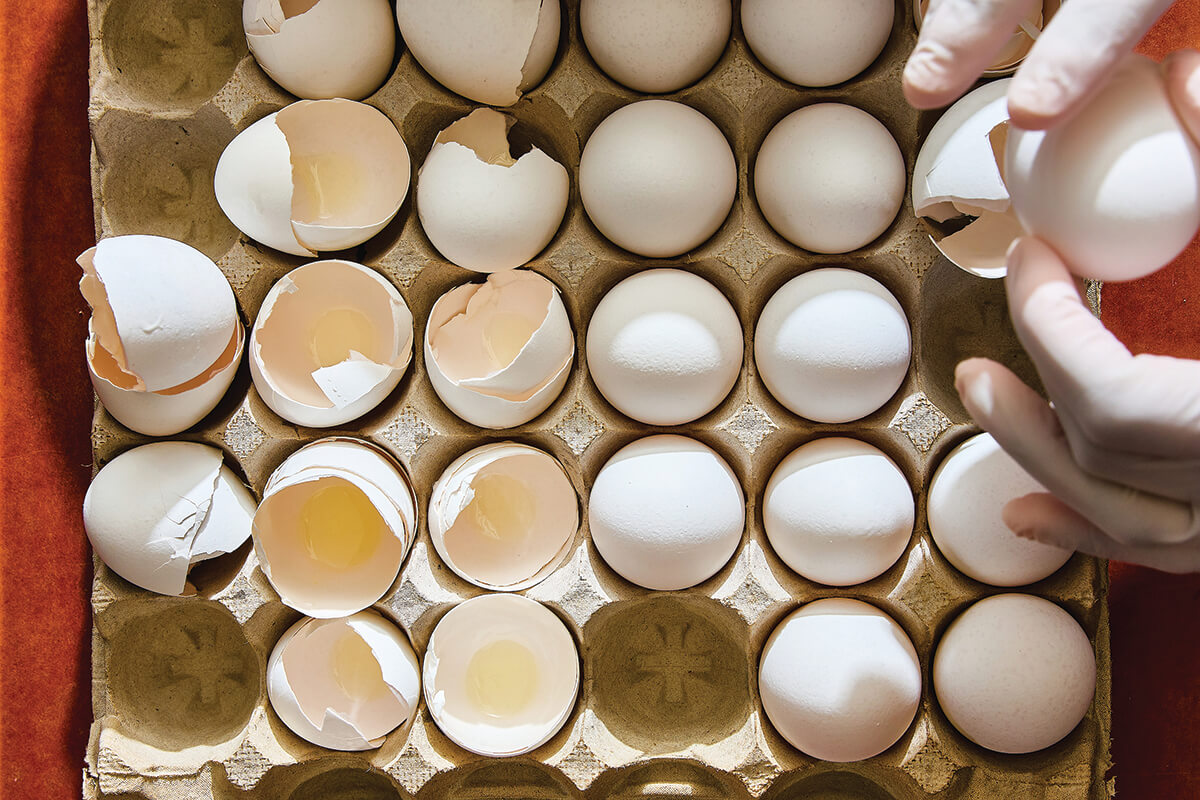
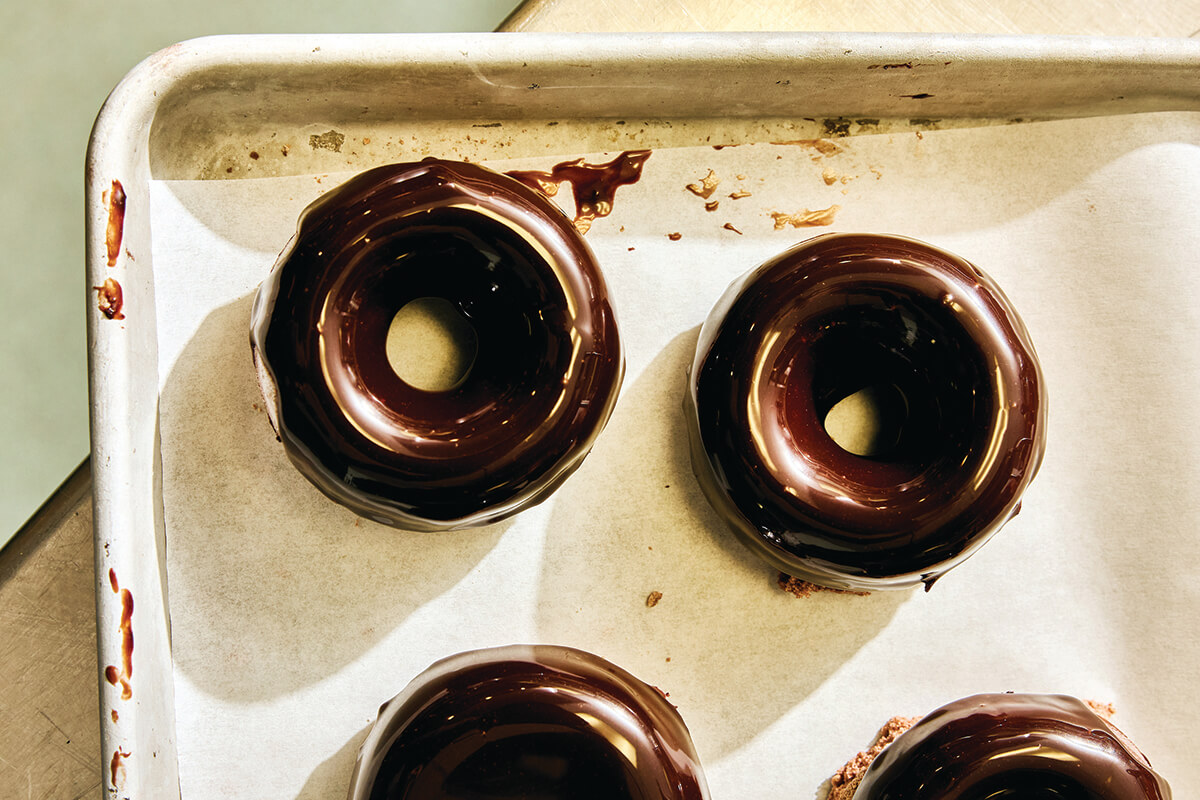
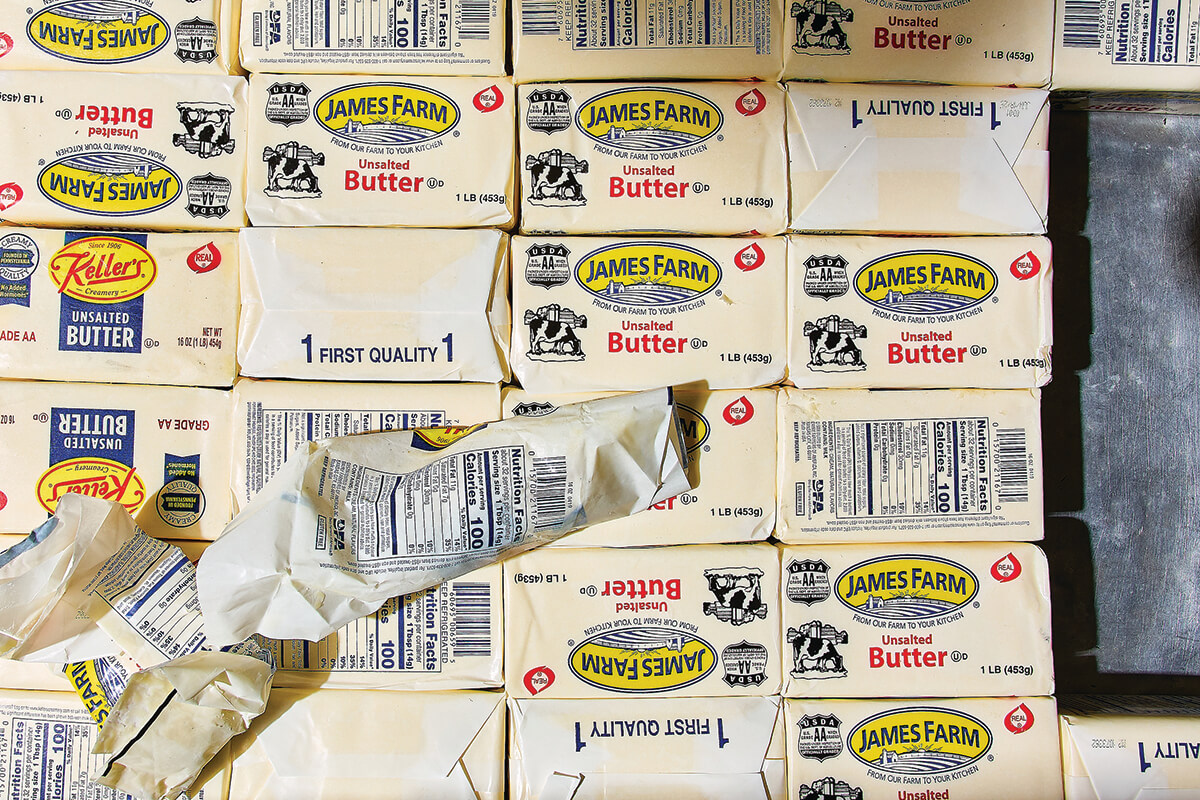
Like Gjerde, Ammoora’s executive chef Matthew Milani was originally a pastry chef. The Syrian restaurant at the Ritz-Carlton Residences in Federal Hill, which was named to The New York Times’ 50 Best Restaurants list in 2024, has a strong pastry program that encompasses a large dessert menu as well as house-made breads, including the pita breads that are an essential part of the Levantine menu. That Milani started in pastry—he has a degree in pastry from Le Cordon Bleu in Lyon, France—helps maintain both the quality and focus of the dessert menu.
It also doesn’t hurt that Ammoora’s owner, Jay Salkini, also owns a baklava factory in Lebanon. As part of the Ritz-Carlton, Ammoora has a banquet room and does wedding packages as well as hosting private events. Milani catalogs all the items that come under the umbrella of the pastry program—fruit sauces, croutons, dehydrated fruit for the cocktail menu, all the ice creams—in addition to the actual desserts.
And those desserts are like nothing else in Baltimore. The asha bil asal is “a play on a pastry cream mouselline,” describes Milani, crowned with rose petals, pistachios, and a stunning thatch of rose-flavored cotton candy; and the ruz bil karaz is a dessert of coconut rice pudding, confit sour cherries, and a coconut-caramel tuile. Then there’s the pastry kitchen’s masterpiece, a version of the TikTok sensation Dubai chocolate bar, with toasted knafeh, pistachio-tahini batter, white chocolate cremeux, chocolate ganache, caramel espresso, and crushed pistachios.
“I love the position; I wish they got more recognition,” says Milani of pastry chefs, as he takes a break in the restaurant’s foyer one weekday mid-afternoon. He just finished Baltimore’s Restaurant Week, when he and his staff made hundreds of Dubai chocolate bars. “It was the greatest and worst decision ever. I think everybody got covered in pistachios at some point, just trying to keep up,” he says.
“It doesn’t have to be a 15-tier wedding cake,” he says of a restaurant’s dessert menu. “A plated dessert can really go a long way.”
Restaurateur Tony Foreman says he values investing in a pastry program because he appreciates “the care, the intentional ‘I’m going to treat you better’ ethos that there is in pastry.”
What allows Foreman to have executive pastry chef Maiya Lonesome on staff, plus a three-person team supporting her, is that they make desserts for all five of his restaurants and do it all from the huge Harbor East production kitchen at Cinghiale. Lonesome has been with Foreman for three and a half years, having graduated from Johnson & Wales in pastry and worked in D.C. hotels before coming to Baltimore.
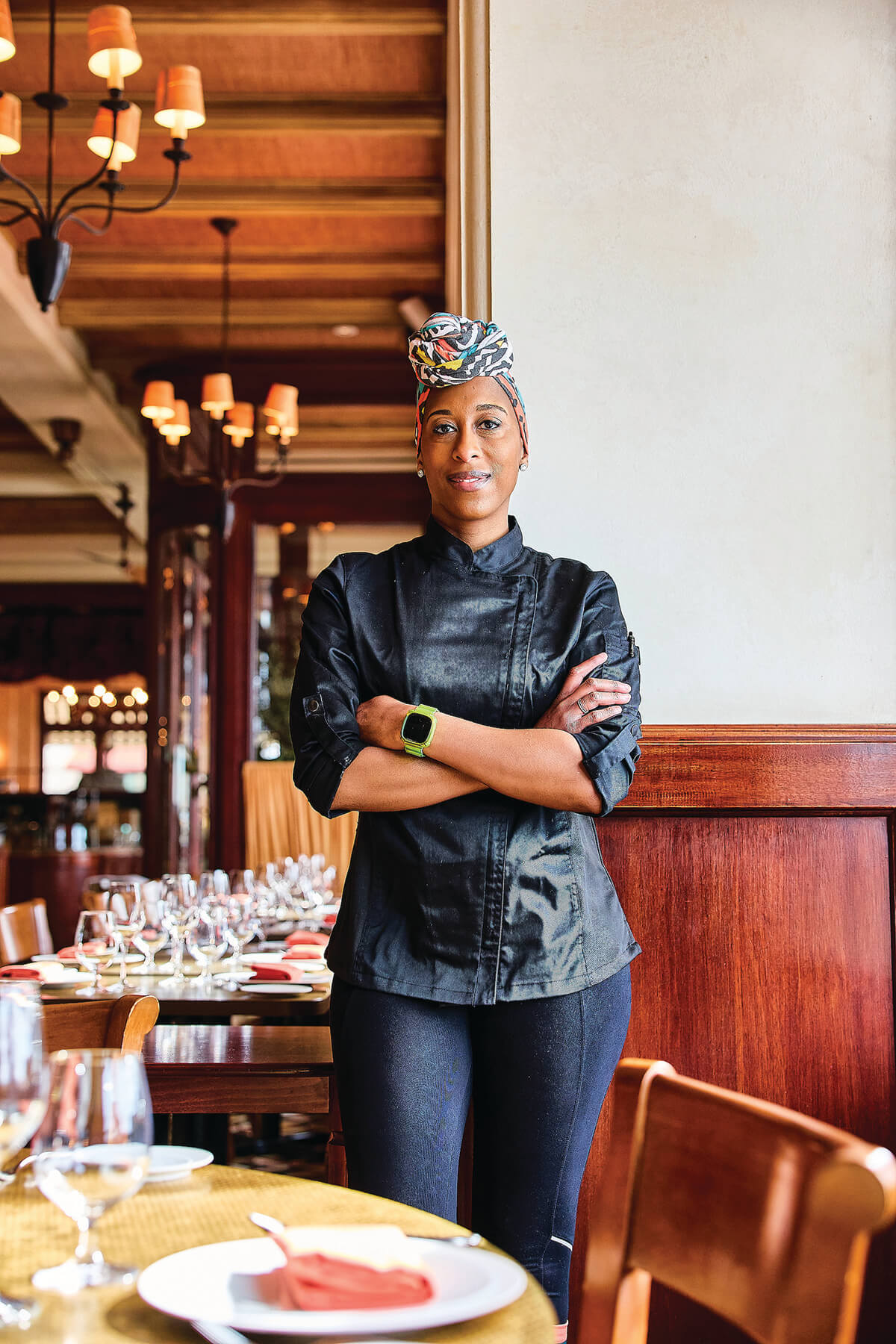
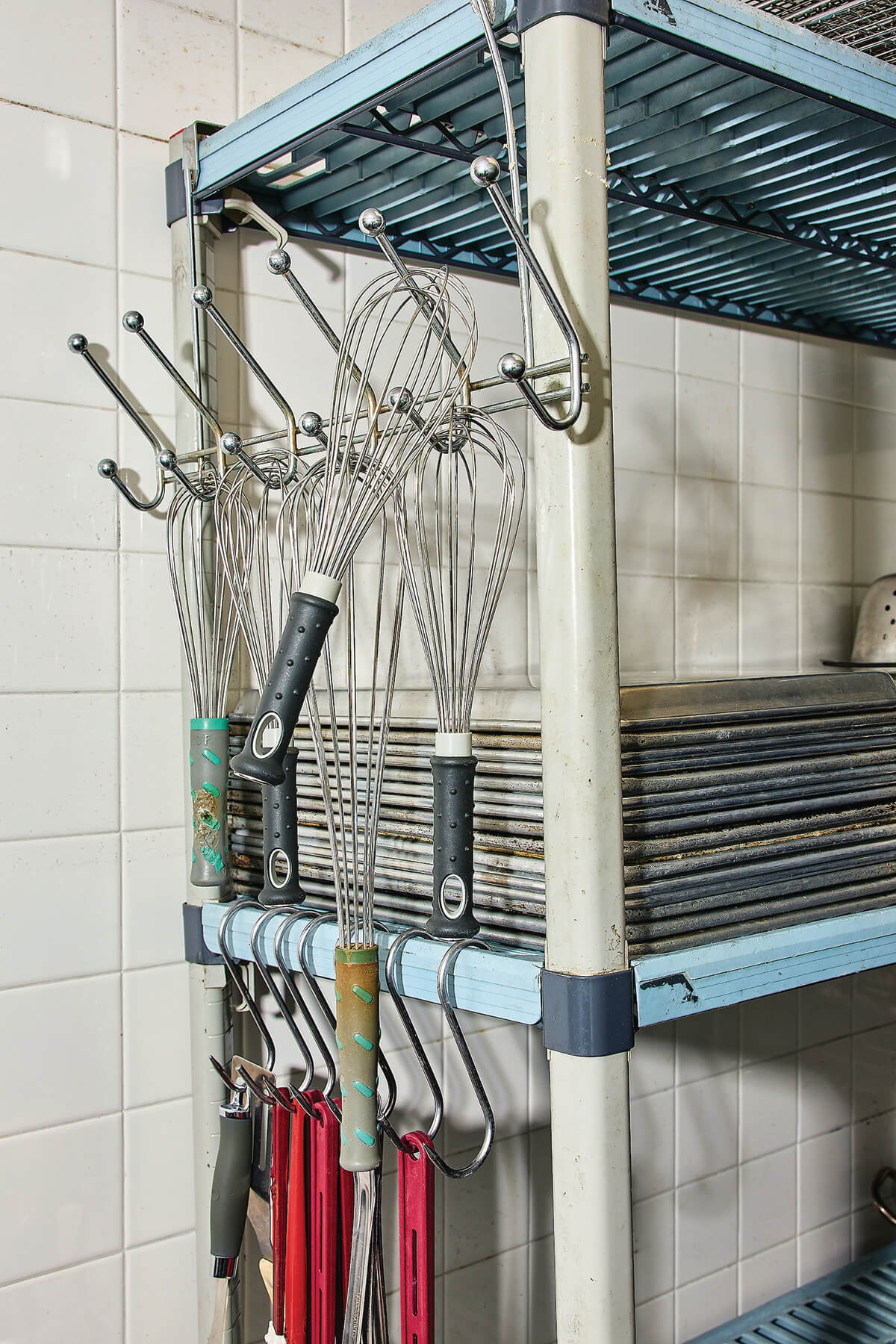
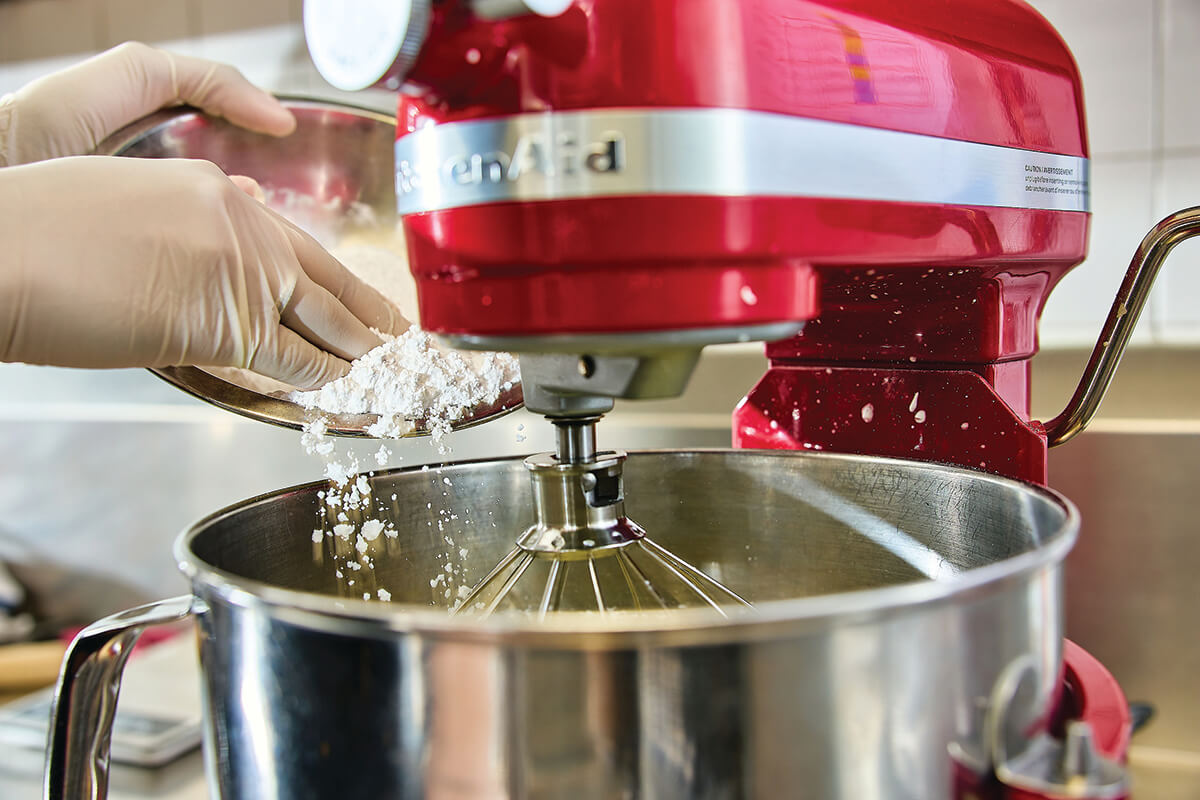
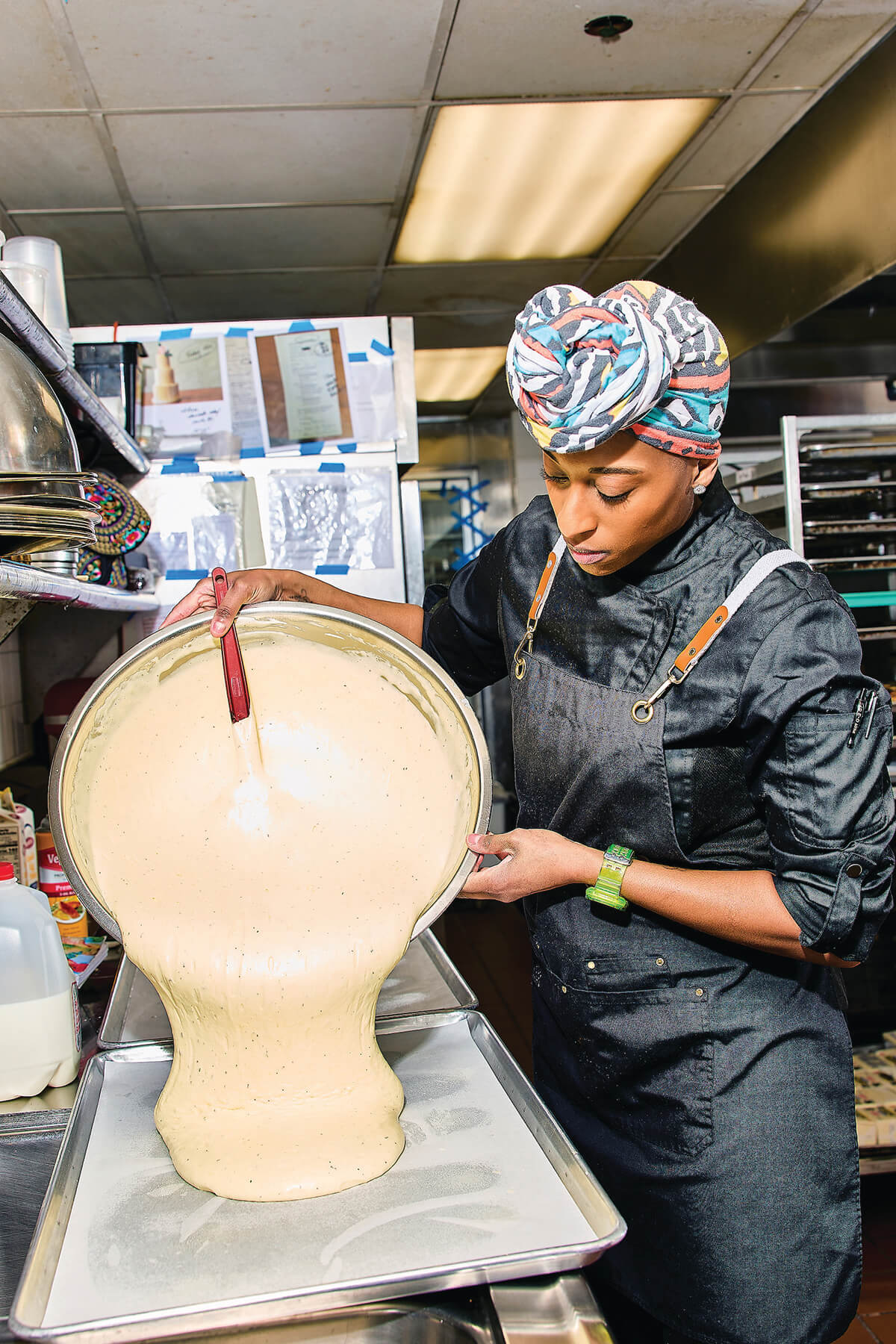
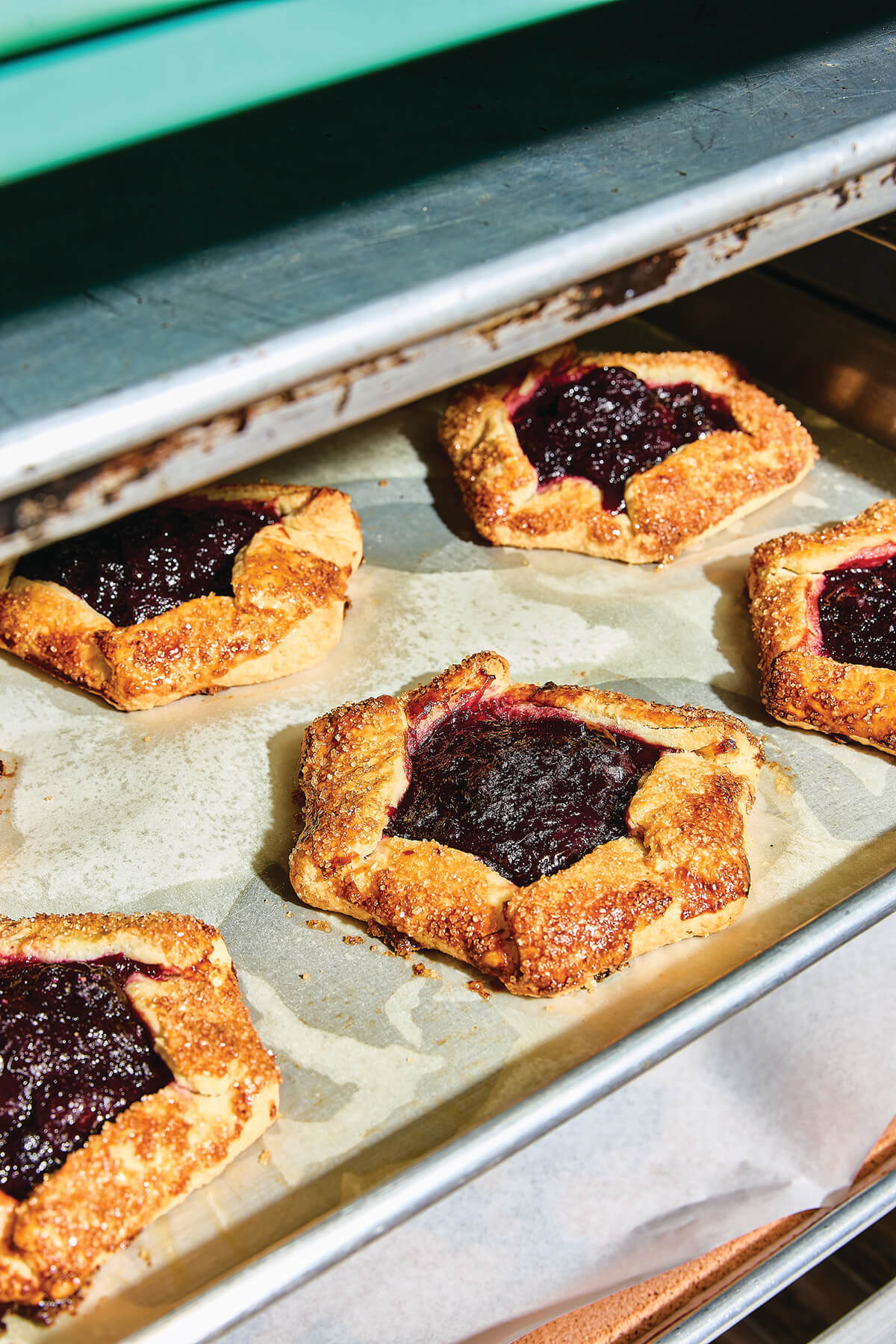
“Every holiday is always insanity,” says Lonesome of her job. “Five restaurants, easily over 400 covers per restaurant, and everybody gets dessert,” at least during those holidays. Not only is the high cost of ingredients an issue, says Lonesome, but even finding people trained to work in pastry is difficult these days.
“The pastry kitchen is the first to get cut,” says Lonesome. “I have friends who got out of the industry. Their biggest thing was feeling like they weren’t getting paid enough. The hours are grueling. The work can be really hard on your body. It’s not conducive to having a family. So that left us with a big gap going into the pandemic, and then that happened, and then the gap just widened more.”
Another issue, she says, is the availability of outsourced desserts. “The introduction of a lot of convenience products dug a little bit of a grave for some of the pastry chefs out there,” says Lonesome. It’s a common concern.
“In a lot of restaurants, the desserts are coming from elsewhere,” says Woodberry’s Gjerde. “You can get it from Sysco, like everything else. Take it out of the freezer, and who’s gonna be the wiser?”
“THE HOURS ARE GRUELING. THE WORK CAN BE REALLY HARD ON YOUR BODY. IT’S NOT CONDUCIVE TO HAVING A FAMILY.”
In Cinghiale’s kitchen, Lonesome places a tray of 40 individual chocolate cakes filled with chocolate Bavarian cream in the freezer. Once frozen, they’ll get topped with chocolate mirror glaze, then driven to Sparks for The Milton Inn, where they’ll be decorated with white-and black sesame tuilles for the chocolate gâteaux.
Lonesome, who usually comes into the kitchen in the early morning to make her desserts long before the dinner team arrives, expertly spreads an Earl Grey sponge cake onto parchment-lined trays. Nearby are sheet racks of cherry crostatas for Cinghiale and cookies for Johnny’s, Foreman’s Roland Park restaurant; one tray is stacked with blocks of butter like an architect’s stash of bricks. Taped to the side of the freezer is a series of production schedules as well as photos of wedding cakes: Lonesome and her team also bake for weddings and events.
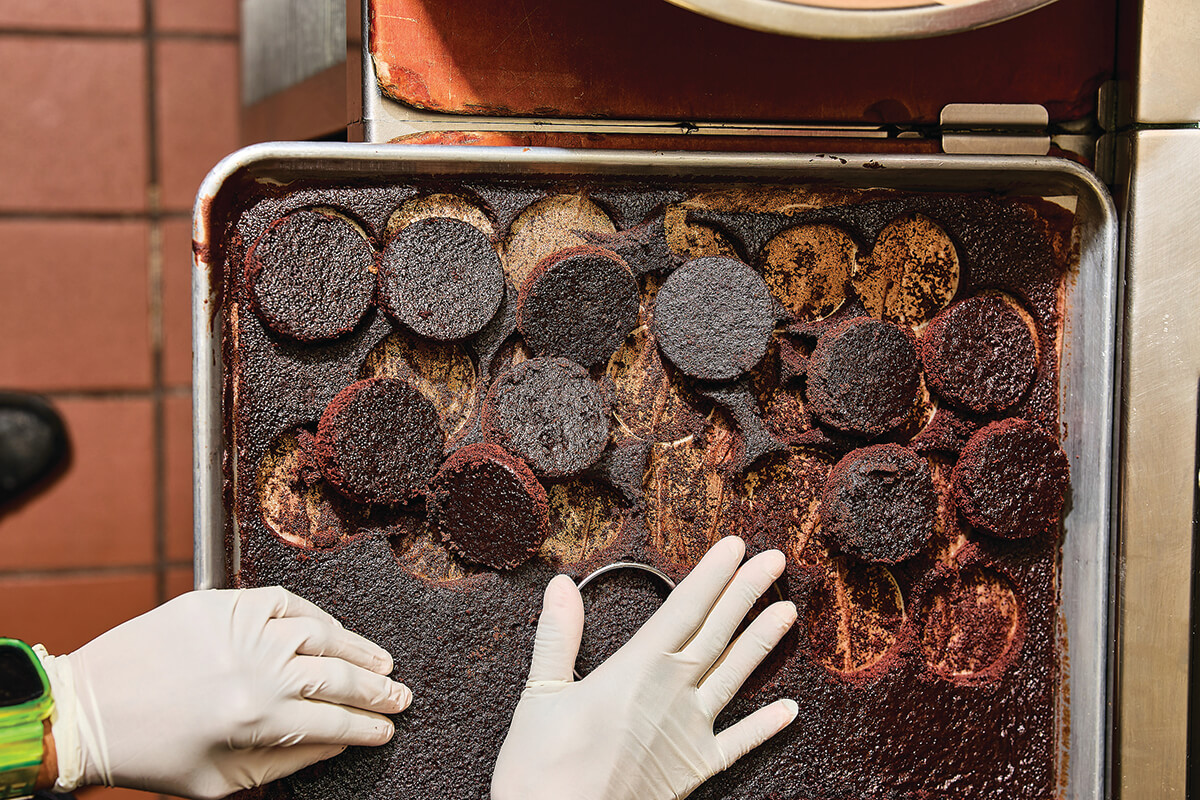
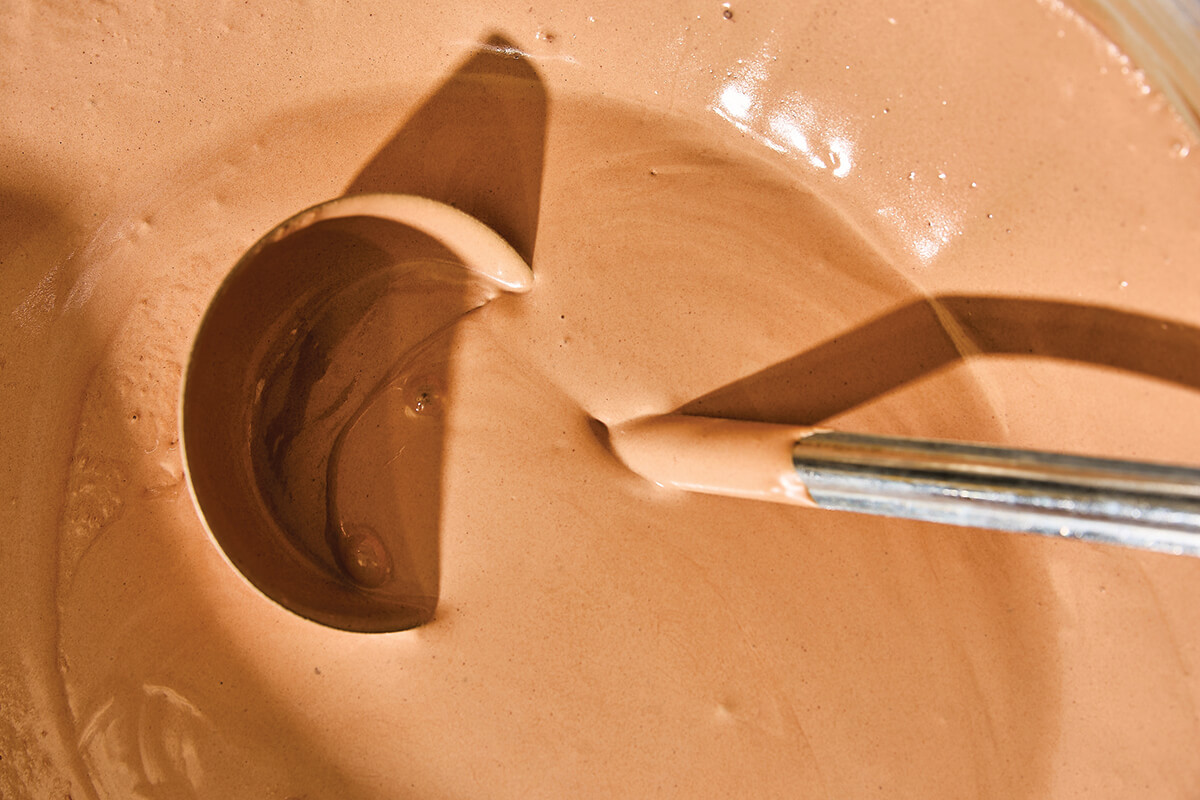
She first got interested in cooking in her eighth-grade home-ec class and decided to be a pastry chef while still in high school. “I wanted to do wedding cakes; I wanted to do chocolates and sugar.”
Back in Magdalena’s kitchen, Heleba turns her attention to a tray of banana slices, which she brûlées with a Home Depot-sized torch before tweezing them alongside rectangles of banana cake.
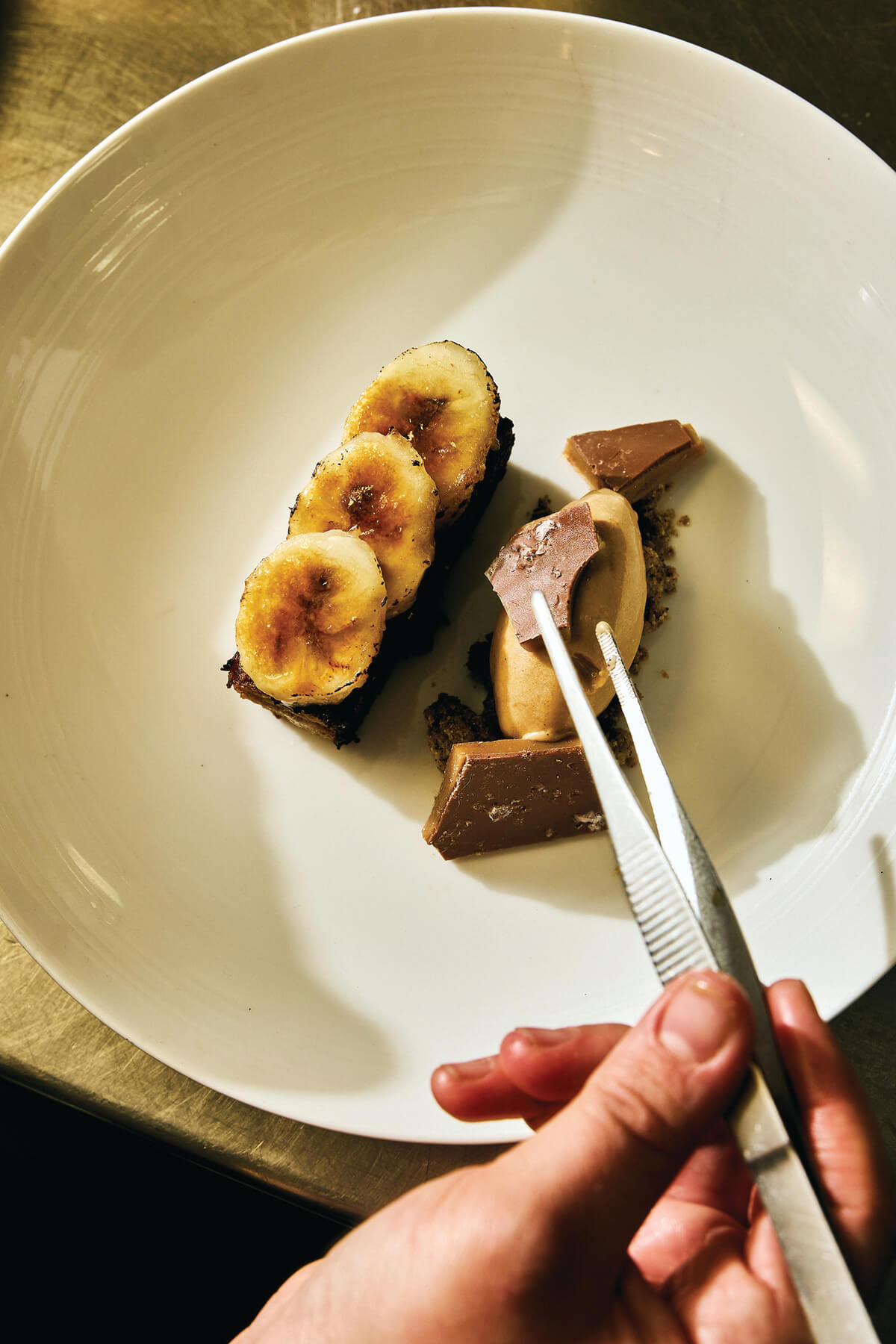
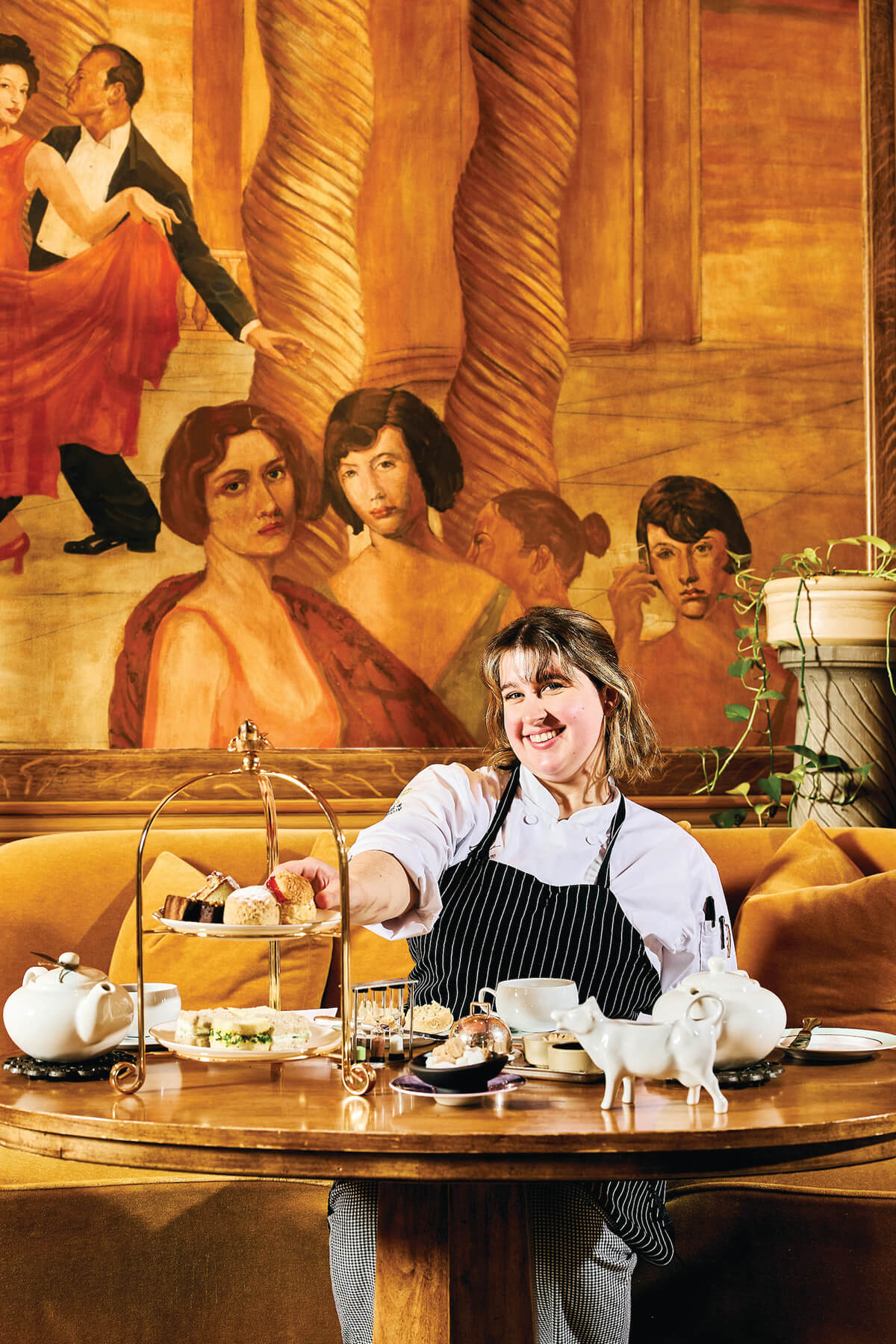
Under her expert touch, the cakes are outfitted with toffee ice cream, espresso crumbles, and shards of house-made toffee, then showered with Maldon salt for the finished banoffee desserts.
“I feel sad when I go to a restaurant and they have this beautiful menu with all these fresh ingredients and techniques, and then at the end there’s these same four desserts that you could get anywhere,” she says, spooning the ice cream into perfect oval-shaped quenelles. “I think you should end a meal with a reflection of what you’ve just enjoyed.”